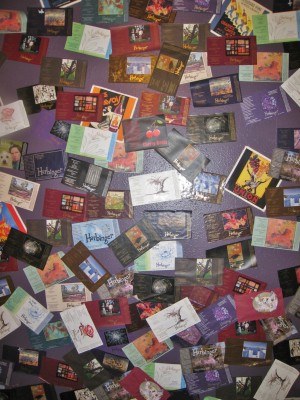In my last post, I told you about our visit to Locke, California, on The California Delta. After our visit, we got back on Highway 160 and were enjoying the scenery when we saw a huge, old brick building. We knew it must have been a factory of some sort, but didn’t know what kind. Then we saw a sign announcing that we were coming up to the town of Clarksburg, and there was wine tasting at the Old Sugar Mill! Well, duh, of course we had to stop – it was wine tasting in a historic sugar mill!

The Front Entrance of the Old Sugar Mill
The Old Sugar Mill was a beet sugar mill that was originally owned by the Amalgamated Sugar Company. This particular mill was built in Logan, Utah in 1897, and closed in 1933, due to blight and drought in Utah. At that point, the company dismantled the mill and moved it to Clarksburg, where it was reconstructed and opened again in July, 1935. The mill changed hands a couple of times, but had a long run processing beet sugar from surrounding farms, before finally closing for good in 1993.

The unrestored section of the Old Sugar Mill
In 2000, a plan was made to convert the mill into winery crush and retail space, and the first winery opened there in 2004. The Old Sugar Mill has 10 wineries operating there now, and the mill is huge, with a lot of yet to be converted space. Since we had never visited before, I did what any self-respecting wino wine connoisseur would do; I found a lady in the restroom who was carrying wine, and I asked her which were her favorites. She said Todd Taylor and Rendezvous.
Todd Taylor was closer to the restroom, so we headed there, and ran into Todd himself. He led us through his lineup of Sauvignon Blanc, Pinot Noir and Zinfandel. I liked them all and was pleased by how much I enjoyed his Carneros Pinot Noir. If you remember my posts on my March trip to the Anderson Valley, you know I wasn’t blown away by the Anderson Valley Pinots we tried. Todd Taylor’s Pinots were wines I really enjoyed! And his Zinfandel was excellent as well.

The Interior of the Old Sugar Mill – I love those Brick Walls!
We asked Todd for his recommendation on another winery that did Zinfandels, since Jon wanted to make sure we tried some good Zins on this trip. Todd recommended Three Wine Company, just down the hall, so we headed there next.
Three had a larger lineup, with a complimentary tasting of 5 wines. It is the latest project of Matt Cline, who worked for many years as the winemaker at Cline Cellars. The first wine was released in 2008. For my tasting, I tried their Sauvignon Blanc, Riesling, Old Vine Zinfandel, their Field Blend, and the Petite Sirah. My favorites were the Riesling, a nice semi-sweet Riesling, and the Old Vine Zinfandel (actually a blend of Zinfandel, Petite Sirah, Carignane, Mataro (also known as Mourvèdre), and Alicante Bouschet). I wasn’t a fan of the Field Blend, but I liked the Petite Sirah. It was a big tannic wine, but I think it would soften over time.

Christmas at Three Wine Company
We wrapped up our purchases at Three and headed out just as the Old Sugar Mill was closing for the day. We drove back to Roseville to meet up with Jon’s friend Pablo and his girlfriend Jessica for dinner at Sushi Nami. They were having their “appetite stimulus package” sale, which meant that any of their sushi rolls was on sale for half price. HALF PRICE! It was advertised as a limited time only, but Pablo said that this special has been going on for a couple of years now. I would totally visit all the time if I lived nearby!
We had a good time catching up, but unfortunately Pablo and Jessica couldn’t stay very long, and we were on our own again. We headed back to the hotel for an early night, as Jon’s race would be here before we knew it!













